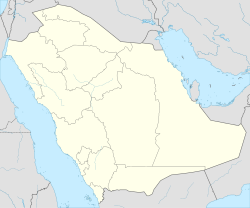
Riyadh, formerly known as Hajr al-Yamamah, is the capital and largest city of Saudi Arabia. It is also the capital of the Riyadh Province and the centre of the Riyadh Governorate.
Abdul Muhsin bin Abdulaziz Al Saud was a member of the House of Saud, the governor of Medina, and one of the leading poets in Saudi Arabia. He was a lover of literature, poetry and historical books.
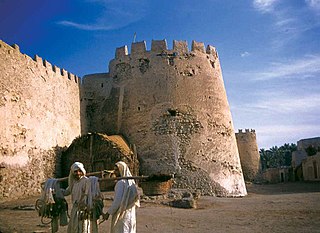
Qal'at al-Qatif or Qatif Castle was a historic castle in the city of Qatif, Saudi Arabia. Initial construction of the castle dates back to the third century by the Sassanids. It was then refurbished by the Ottomans and utilized as a defensive military base for the Persian Gulf region. Later, the castle was turned into a civilian-purpose warehouse for the locals. The castle itself was a massive complex of densely populated area and several facilities, including eleven mosques, a keep for the king, keeps for the guests, which are surrounded by the citadel wall. It was oval-shaped, and John Gordon Lorimer estimated that the longest side reaches 365 meters from the east to west, and it reaches 275 meters from the north to south. At its peak, it contained the population of 5,000, and 300 shops. It also equipped moat and farmlands for orchard, connected to nearby Qatif oasis. The castle was destroyed in the 1980s, after the ownership was taken away from the locals, and the buildings and houses were gradually removed. Today, there are only 18 houses left in the field with the rest of the places turned into a public square and parking lots.
Jabal al-Baidain is a mountain located in the province of Dawadmi of the Riyadh Region in central Saudi Arabia. The mountain is famous for its archaeological value, drawings and Thamudic inscriptions.

Al-Mubarraz is a city located at Al-Ahsa in the Eastern Province of The Kingdom of Saudi Arabia, and it's the north gate for Al-Ahsa governorate. With a population of 837,000. Al-Mubarraz has historical importance because it was the rule center for the district between 1669 and 1793, before the Saudi rule . there are some sayings about its origin and it said that its origin back to the second half of the seventh century in Hijri.

Muhaires castle located in Al-Ahsa governorate, at the eastern region of Saudi Arabia. the castle was built by Al-Imam Saud bin Abdul-Aziz on the top of a hill at 1208 Hijri for military purposes. It is a small military castle consist of round towers with rooms, Weapons, supplies and ammunition were stored there. This castle existed during the battle between Al-Imam forces and Zaid bin Uray'er forces, and expelling them from the north of Al-mubarraz and the northern villages.

Al-Qarah mountain "Jabal Al-Qarah" also known as Al-Shabaabn mountain" is located between At-Tuwaitheer village and Al-Qarah village in Al-ahsa in the Eastern Province, Saudi Arabia. This mountain counts as one of the most important natural sights in Al-Ahsa and is registered in the UNESCO world heritage center's list in 2018, after the inclusion of Al-Ahsa oasis. It's positioned 15 kilometers away ofAl-Hofff east. The mountain has caves, and some of them, such as "Al-Nashab cave", have a moderately steady temperatures throughout the year.
Al Khankah is an Egyptian administrative center. It is located in Qalyubia Governorate, within the Greater Cairo Region in the Arab Republic of Egypt. The administrative base of the center is the city of Khanka, and it also includes the city of Khusus.
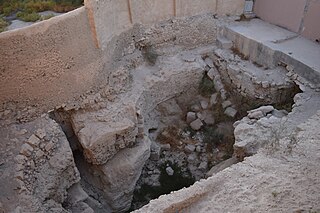
Odeh Spring is a historical natural underground deep sulphur spring in Saudi Arabia, Eastern Province, Qatif, specifically in Tarout Island. Odeh Spring history goes back more than four thousand years. It contained mineral water where people utilized it to cure diseases and illnesses. Odeh Spring used to produce hot water and vapor in winter, and lukewarm water in the summer. In spite of all the different attempts and efforts to revive it, the spring is currently depleted.
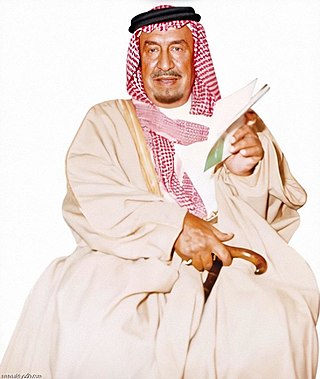
Mohammed bin Saud Al Kabeer was a Saudi royal and businessman. He was a nephew of King Abdulaziz. He was the patriarch of the Al Kabeer clan and a senior prince due to his in-depth tribal knowledge and connections. His nickname was Shaqran.
Muhammad Bahjat Athari was an Iraqi linguist, historian and investigator, student of Mahmoud Shukri Al-Alusi.
Osama Manzlaji is a Syrian translator. He was born in Latakia in 1948. He translated many literary works from the English language. One of the most known writers whom he’s translated for is Henry Miller, Hermann Hesse, and Terry Eagleton.
Jahan Ghazzawi Aouni was a Lebanese writer, literary critic, and teacher. She was born in Tripoli and grew up there and studied at the Tallian Institute. She dropped out of school after her mother died to take care of the house, so she learned my age. She taught from 1946 until her death at the age of 38 or 40. She has been known for her work in the area of women's empowerment, has contributed to many charitable social activities, and her home has been a moral good. She was nicknamed Vihah. She left manuscript works, numerous articles and stories published in newspapers, with notice. She wrote several articles about Mei Zia, and she well known for defending her in literary criticism.

Al-Malazz, formerly al-Riyadh al-Jadidah and the Red Sea neighborhood, is a commercial and residential neighborhood and the seat of the sub-municipality of its namesake, Baladiyah al-Malaz in downtown Riyadh, Saudi Arabia. Named after the al-Malaz Square, it was built between 1953 and 1957 by King Saud as a housing project for government employees and was later turned into a full-fledged district.
Dirwish Hanafi Darwish, better known as Darwish al-Asywti. Dirwish is a writer, poet, playwright, screenwriter and researcher in Egyptian folklore.

Riyadh Water Tower, locally known as Burj al-Khazzaan or simply al-Khazzaan, is a 61-meters tall conical-shaped cylindrical water tower and a prominent cultural landmark in the al-Futah neighborhood of Riyadh, Saudi Arabia. Designed by Swedish architect Sune Lindström and modeled after the Svampen water tower in Örebro, Sweden, it was the tallest structure in the country at the time of its inauguration in 1971.

The National Museum Park is an umbrella term used for the agglomeration of 5 out of 8 municipal parks and gardens in the al-Murabba neighborhood of Riyadh, Saudi Arabia, namely al-Haras, al-Soor, al-Wadi, al-Jisr and al-Madi that adjoin the Murabba Palace compound and the premises of National Museum as well as the King Abdulaziz Foundation for Research and Archives in northern section of the King Abdulaziz Historical Center.

The One Hundred Palm Trees Park, officially known as the Palm Oasis, is an unfenced municipal garden located between al-Watan Park and al-Yamamah Park in the al-Fouta neighborhood of Riyadh, Saudi Arabia. Inaugurated in 1999, the park is characterized with 100 date palm trees that were planted to commemorate the centenary year of the Battle of Riyadh in 1902 and the subsequent establishment of the Emirate of Riyadh by Ibn Saud. It is one of the eight municipal parks and gardens of the King Abdulaziz Historical Center and is located at the south-center of the compound, overlooking the King Saud Road and the Murabba Square in the National Museum Park.
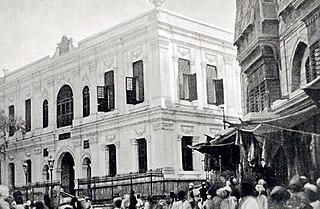
Al-Hamidiyah Palace or al-Hamidiyah Building was an Ottoman-era double storey government building in the Ajyad district of Mecca, Saudi Arabia. The building played a crucial role in the country's modern history as it was the location from where Prince Faisal bin Abdulaziz announced the official establishment of Saudi Arabia on King Abdulaziz's behalf. Built by the-then Ottoman governor of Hejaz Osman Nuri Pasha in 1885, it was named after Sultan Abdul Hamid II. The structure was completely razed down in 1957 during the reign of King Saud in order to pave the way for the Grand Mosque's expansion.
